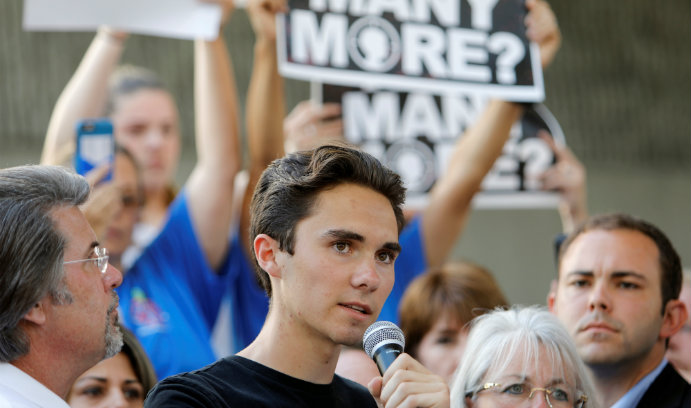Q&A: Will Student Activism Around Parkland School Shooting Change Anything?

David Hogg, a senior at Marjory Stoneman Douglas High School, speaks at a rally calling for more gun control three days after the shooting at his school, in Fort Lauderdale, Florida. Feb. 17, 2018. Photo: REUTERS/Jonathan Drake
On Feb. 14, 2018, a young man with a semi-automatic rifle entered Marjory Stoneman Douglas High School in Parkland, Fla., and began shooting. Bullets killed 14 students and three school staff members, wounding 17 others. The suspected gunman was Nikolas Cruz, 19, a former student at the school. In the weeks since the tragedy, one of the deadliest school shootings in American history, student survivors have taken to social media and public forums to advocate for gun control legislation. Their efforts include meeting with the president and lawmakers and organizing a march on Washington, D.C. Students, celebrities and others around the country have joined the #NeverAgain movement started by the Parkland students.
Anthony DiMaggio is an assistant professor of political science who specializes in social movements, mass media, public opinion, interest groups and inequality.
1. Is the response to this shooting different from responses to prior mass shootings?
The emergence of a youth movement to regulate guns is potentially very significant. The National Rifle Association is widely recognized as dominant in influencing public policy on guns, so the rise of a competing political force will be vital to electing new political leaders and pressuring current political leaders to consider some set of reforms related to gun ownership. Social movements historically are vital to transforming national consciousness on political matters, so a youth movement aimed at gun regulation could have a major impact on changing American political culture. And previous scholarly studies of NRA lobbying suggest that most of its influence is rooted in voting power of its members, rather than campaign donations. This suggests that, if there were a countervailing force to organize in favor of gun regulations, it could also exercise significant influence via the power of the vote.
Protests against gun violence in the U.S. are hardly a new phenomenon. But with the rise in the frequency of mass shootings, the issue of gun violence and regulation is growing. Within the last few years, support for increased gun regulations has grown significantly. A new Quinnipiac poll finds that 66 percent of Americans support stricter gun regulations, up 7 percent from December. It seems that public opinion is beginning to tip in favor of taking action on the issue of gun violence. With a sustained push for change on the part of the part of the citizens, almost anything is possible.
2.Could these efforts lead to changes in policy or public opinion?
If these activists are continually engaged, and manage to sustain sympathetic media attention for their cause over an extended period of time, the chances are good they will be able to mobilize many Americans regarding gun regulation. Social movements have historically used the media to build mass support for political change, and the potential is present here for this to happen again. This is a process that usually takes some time to have any impact, since it requires mass cultural change in the public’s attitudes toward guns. I suspect it will be much the same with mass shootings and pressure for more gun regulation.
The prospects for reform are real, at least if there is sustained public pressure in coming months and years on government to act. This is a very sensitive public issue, and mass anger at political officials will likely convince many in Congress to take regulation more seriously. We have already seen some of this in Florida, with legislation changing the legal age to purchase guns from 18 to 21, and the prohibition on bump stocks.
3. What will happen next?
It's difficult to say what will happen next for sure. No policy change advocated by an interest group or social movement is ever inevitable. Such changes are entirely contingent upon how hard people want to fight for them. The question is when the public will reach its breaking point, after which mass anger produces consistent pressure from below for change. The mass public is growing increasingly skeptical of the status quo. With the rise of youth protests, we may be in the middle of a significant political transition period.
4. How much of the response is being driven by political polarization?
Mass polarization isn't as great as many might think. Most Trump and Clinton supporters support banning those on the federal terror watch list from buying guns, preventing the mentally ill from obtaining guns, and want expanded background checks. And the issue of mass gun shootings, especially against children, is universally condemned in the U.S. So public support for reform is already quite strong. It is more a matter of reform supporters consistently organizing and combating the formidable influence of the NRA. (For more on these attitudes, see the Pew Research Center’s findings.)
5. Could this be a tipping point?
I think we are very close to a tipping point, if not already there. The status quo of mass killings, especially against children, will not be allowed to continue forever. I know of no individual, conservative or liberal, who is comfortable with mentally disturbed individuals using assault weapons to murder children. The pressure for change is now readily apparent, and this pressure will likely mean some sort of political reform in the future.
President Trump's recent pressure on other Republicans regarding gun control, and his signaling that he is open to expanded background checks, demonstrate the potential for bipartisan compromise on this issue, although of course the NRA will continue to exert a strong impact on the Republican Party as well. But the issue of gun violence in schools has the potential to transcend traditional partisan boundaries.
Posted on:





